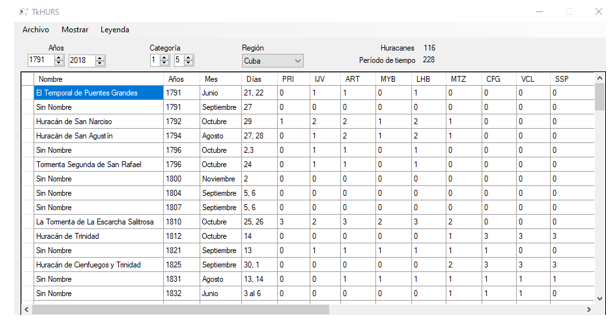Statistical software to calculate hurricane return periods
Main Article Content
Abstract
The greatest natural disasters registered in our country’s history have been associated with tropical cyclones. The great cyclonic activity that has taken place in the past few years has focused the attention the climatology of these events, their variability and their tendency on the long haul. Several hurricanes have caused disasters of great magnitude, due, fundamentally to the number of diseased according to the impact of the storms. According to the revised trajectory of the hurricanes that thrashed the Cuban island and the surrounding seas, the Cuban Republic territory has different sensibilities regarding the degrees of damage. This is the main reason behind the development of the TkHURS software to obtain the return periods and calculate the estimated frequencies.
This procedure is performed through a Poisson Model Fitting of the variable that counts the number of hurricanes that thrashed Cuba on the period 1791-2016, from the Chronology of Tropical Cyclones and General Weather States. We propose a methodology to have a better understanding of how to use the software. With the most representative model to fit the data, we allow to estimate values closer to reality and to better understand the analyzed variable regime. In addition, we offer these services to several institutions to obtain an economical gain.
Downloads
Article Details

This work is licensed under a Creative Commons Attribution-NonCommercial 4.0 International License.
Those authors who have publications with this journal accept the following terms of the License Attribution-NonCommercial 4.0 International (CC BY-NC 4.0):
You are free to:
- Share — copy and redistribute the material in any medium or format
- Adapt — remix, transform, and build upon the material
The licensor cannot revoke these freedoms as long as you follow the license terms.
Under the following terms:
- Attribution — You must give appropriate credit, provide a link to the license, and indicate if changes were made. You may do so in any reasonable manner, but not in any way that suggests the licensor endorses you or your use.
- NonCommercial — You may not use the material for commercial purposes.
- No additional restrictions — You may not apply legal terms or technological measures that legally restrict others from doing anything the license permits.
The journal is not responsible for the opinions and concepts expressed in the works, they are the sole responsibility of the authors. The Editor, with the assistance of the Editorial Committee, reserves the right to suggest or request advisable or necessary modifications. They are accepted to publish original scientific papers, research results of interest that have not been published or sent to another journal for the same purpose.
The mention of trademarks of equipment, instruments or specific materials is for identification purposes, and there is no promotional commitment in relation to them, neither by the authors nor by the publisher.
References
González, J. A. (2012). El lenguaje de programación C#.
Gray, W. M. (1984). Atlantic Seasonal Hurricane Frequency. Part I: El Niño and 30 mb Quasi-Biennial Oscillation Influences. Monthly Weather Review, 112(9), 1649-1668. https://doi.org/10.1175/1520-0493(1984)112<1649:ASHFPI>2.0.CO;2
Landsea, C., Franklin, J., & Beven, J. (2014). The revised Atlantic hurricane database (HURDAT2) [Database]. The National Hurricane Center (NHC). http://www.aoml.noaa.gov/hrd/hurdat/newhurdat-format.pdf.
Pérez, R. (2006). Cronología de los Huracanes de Cuba. Probabilidad de afectación por huracanes en cada provincia de Cuba [Informe abreviado]. Instituto de Meteorología, Agencia de Medio Ambiente, Ministerio de Ciencias, Tecnología y Medio Ambiente.
Pérez, R. (2013). Cronología de los Huracanes de Cuba [Informe oficial]. Instituto de Meteorología, Agencia de Medio Ambiente, Ministerio de Ciencias, Tecnología y Medio Ambiente.
Roura, P., Vega, R., Sistachs, V., & Alpízar, M. (2018). Caracterización estadística climatológica de huracanes en Cuba durante el período 1791-2016. Revista Cubana de Meteorología, 24(3), 304-312.
Rubiera, J., González, C., Ballester, M., Llanes, M., Caymares, A., Gimeno, Y., & Mojena, E. (2006). Curso sobre Ciclones Tropicales. Academia.
Thai, T. L., & Lam, H. (2003). .NET Framework Essentials (3rd ed.). O’Reilly Media, Inc. https://www.oreilly.com/library/view/net-framework-essentials/0596005059/

